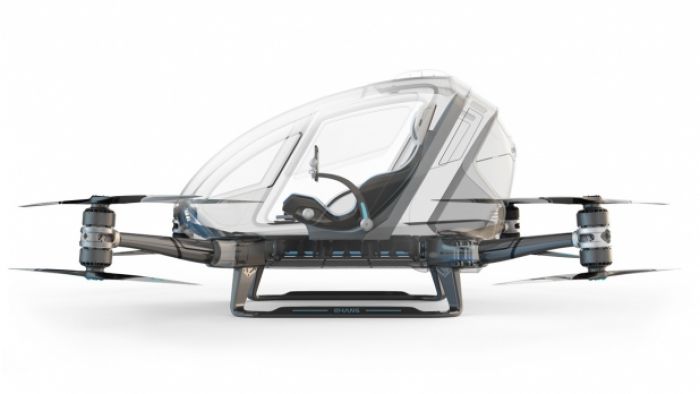This Badass Drone Is Built to Carry a Human Passenger
This year's Consumer Electronics Show included tons of cool products that, chances are, you won't be able to buy. But the biggest, most exciting tease at CES, by far, was the Chinese-made Ehang 184, a drone capable of carrying a human being that's the most sci-fi gadget in years. Never mind those jetpacks that never materialize as products, or promises of driverless cars for sale sometime this decade. This is a self-flying, single-seater robot that will be available this year.
RELATED: The 17 Coolest Things We Saw at CES
The manufacturer has already conducted more than 100 flight tests, including some with a human on board. It operates completely autonomously — you set your destination on its 12-inch touchscreen control panel, click the "take-off" button, and off it goes. In the event of an emergency, a human operator at a flight center will assume control. And the robot's flight system is incredibly redundant, able to land safely with just one of its four rotor motors operational. It flies for up to 23 minutes, and will go on sale in 2016 for somewhere between $200,000 and $300,000.

But the real reason you won't be buying the Ehang 184 has nothing to do with its price, or its relatively short flight time. Toys for the obscenely wealthy have always been a booming business, and the Ehang actually stays in the air for longer than most consumer drones. It might even be considered a valid expense by some companies, depending on how much value they assign to their high-powered executives' time. Plus, can you really put a price on the ability to soar over the worst Manhattan or Los Angeles traffic?
No, what makes the 184 such a non-starter is the Federal Aviation Agency. The FAA remains extremely wary of drones, and with good reason. Cramming residential airspace with flying robots is alarming enough when they weigh around 10 pounds, and their spinning rotor blades have the potential to merely maim. The Ehang 184 is around 441 pounds, and its rotors are only marginally less dangerous than a full-size helicopter's. Ehang's flight safety assurances notwithstanding, how many years of flight tests would have to be conducted, and how many new drone laws would have to be enacted, to allow for such a vehicle in the United States?
RELATED: 9 Awesome Products From the World's Biggest Tech Show
China, meanwhile, is relatively permissive of drone usage, and Ehang sees no regulatory roadblocks in getting the 184 to market there this year. It's possible that the aircraft might also become viable in other non-U.S. countries, where drones are already cleared to fly in areas, and in applications, that are still strictly prohibited here in the states. For the foreseeable future, however, the Ehang 184 won't be buzzing American skylines. Which means that, barring some testing setback between now and the drone's release, China will have human-ferrying robot aircraft up and running, while the West is still fantasizing about its self-driving cars.
Get the latest in gear, fitness, travel & more delivered directly to your inbox. Sign up now for the Men’s Journal newsletter.
